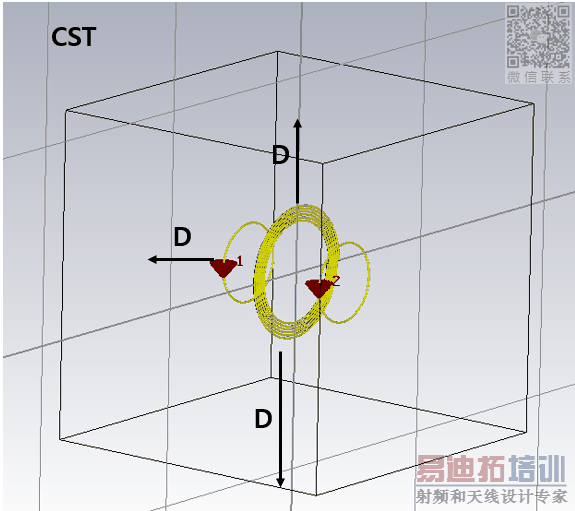- 易迪拓培训,专注于微波、射频、天线设计工程师的培养
Accuracy of CST when changing the size of Radiation Box (compare CST and HFSS)
I want to discuss about the impact of Radiation Box in CST simulation.
I have a system include 2 loops and a spiral coil (a Wireless Power Transfer, WPT System). My purpose is to calculate Resonant frequency of Spiral coils and S21(dB) in CST. Range of frequency = 1 MHz to 10 MHz.
In antenna simulation, Radiation box should be lamda/4 far from Antenna. But in this simulation, it's impossible to do that because of low frequency.
When I change the distance from Boundary Box to Object in CST: D = 1000, 2000, 3000 and 4000 mm, the results change a lot, both resonant frequency and S21.
The target frequency f0 in a WPT system is 6.8 MHz, so if f0 changes 0.5 MHz, it's a problem
Note that: Results in CST is not stable. But in HFSS, it's very stable. In HFSS, f0= 6.7 MHz even when I change D = 2500 or 4000 mm. But I can not use HFSS because it's really low, expencially when I want to simulate a more complex system.
HFSS results also very differ from CST results
1. Do you have any solution to make CST more stable and correct? For example: Meshing...
2. How to choose the size of Radiation box in CST?
3. How to make a same results between HFSS and CST.
Thank you very much for reading.
From the screenshot, it seems that the distance to your simulation boundary is only 2-3x larger than the distance to your pickup coils. It is no surprise that the simulation boundary can change results if it is so close. Carefully check what settings you have used for the boundary condition.
Thank volker@muehlhaus very much.
In CST, Results is unstale. But in HFSS, Results are very stable even when size of radiation boundary is small or large.
Do you have any idea about Meshing of CST and Settings to make results correct? Because using CST is much faster than HFSS in simulating big systems?
Or do you have any idea to make HFSS simulation faster?
Many thanks^^
Check the type of boundary conditions that you have used.
Thank volker@muehlhaus very much.
The boundary conditions in CST is always PML. And in HFSS, I used Radiation Boundary.
I think that PML should be stable, right? So, why results in CST is not stable?
Many thanks
No, that's wrong.
Hi, Even I am interested in knowing what should be the typical size of boundary box in CST.
I have used HFSS a lot but I am new to CST & just started learning it. HFSS has lot of tricks.
For CST, we have experts in this forum. hope they will help.
申明:网友回复良莠不齐,仅供参考。如需专业解答,请学习易迪拓培训专家讲授的CST视频培训教程。
上一篇:In CST 2014, Mesh too dense (++ millions) Can't simulate Please help me.
下一篇:Question about CST thermal-co simulation




